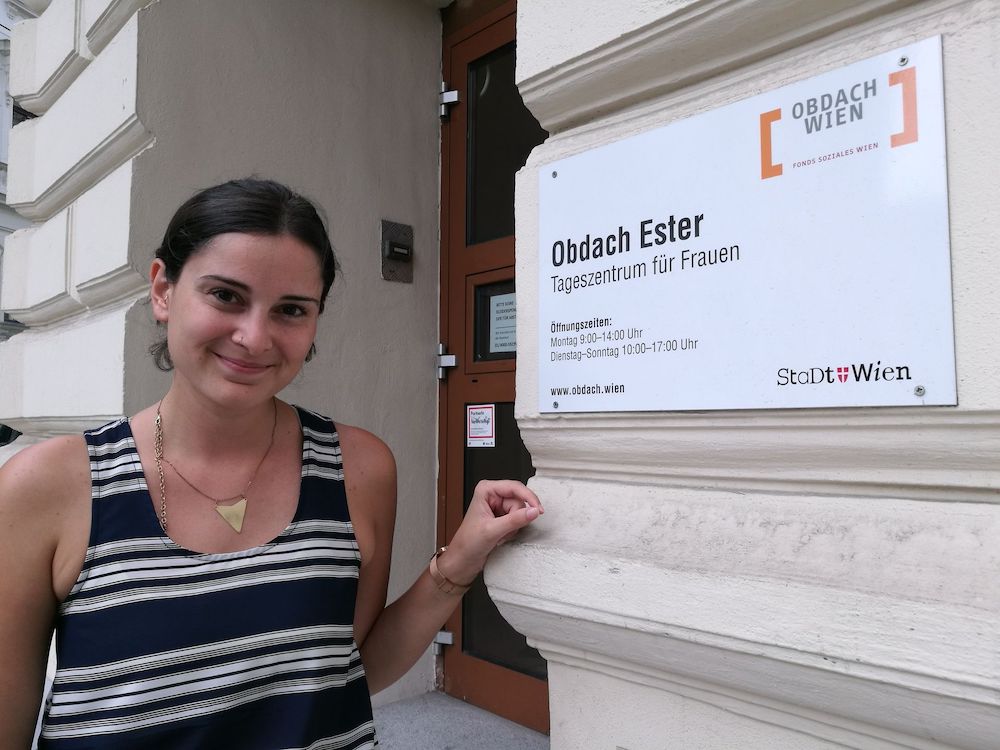- The client is a day center for homeless women.
- The center was moving to a new location and undergoing organizational transformation.
- theLivingCore has implemented a leadership development plan and facilitated the relocation and the onboarding of new members as the team size doubled.
- As the team had a deep sense of attachment to the old facility, theLivingCore fostered a moment of “letting go” of the past and created a mindset of openness and curiosity for the future.
Shelter Ester moves to Cape 10 and introduces dual leadership
Shelter Ester is a day center for homeless women, open 365 days a year. It provides shelter for women off the streets as well as basic services: the possibility to rest in a dry, warm room, amenities for personal hygiene, clothing, and food, as well as counseling and medical support services.
Until recently, the home of Obdach Ester was in Vienna’s 6th district. Then, in 2021, the move to “Cape 10 – House of Social Innovation and Future” took place in the 10th district. We had the privilege to accompany the team of Obdach Ester during the move and to support them in integrating the many aspects of this change process in a meaningful way. In a conversation with Kibar Dogan, team leader of Obdach Ester, we review the year.
The 4 Challenges of Obdach Ester Move
Asked about the challenges that such a move brings, Kibar doesn’t think twice and names four.
- Expansion of space for clients. Shelter Ester moved into a completely new facility, doubling the number of available places for clients from 50 to 100. The team was aware that the move was a hurdle for clients during the pandemic. In addition, they now needed more staff.
- Increasing the size of the team. Before the move, the team at Shelter Ester was manageable: 6 social workers and 6 caregivers. While the move was still underway – in the midst of the pandemic – an extensive recruiting process took place. It was important to Kibar that, despite the pandemic, the applicants had the chance to get to know their place of work as well as their colleagues. Today, 12 social workers and 20 caregivers work at Obdach Ester.
- New team leadership and management methods. Due to the planned team expansion and inspired by a previous project on new leadership methods conducted by theLivingCore, Kibar Dogan and her manager introduced “dual leadership” shortly before the actual move. Dual leadership, in short, means that two people share one leadership position. What sounds simple in theory must be introduced and implemented in practice with a great deal of empathy and trust in the value of dual leadership.
- New tasks for the team. As a consequence of all these innovations, the team faced revised and new tasks. The cards were reshuffled. Establishing new tasks, processes, and courses of action during the move and as part of the team expansion process in a participatory and co-creative approach. Without the opportunity to try them out and test them in advance due to the pandemic, it was definitely a challenge.
“Looking back, I would definitely call that time a big challenge,” Kibar says. “When everything changes at once, it’s an opportunity, of course, because you can take a really big step into the future – but it feels uncertain for long stretches.” The responsibility to bring the project to a successful conclusion was also a burden. Had it failed, it would have jeopardized the success of the entire project. And that’s where Kibar sees a big advantage in dual leadership.
“I find dual leadership immensely valuable. You can exchange ideas, step in for each other, divide up tasks, make decisions together. And, probably the most important thing for me, you’re no longer so lonely as a leader,” says Kibar.

How to Make Dual Leadership Work
We ask what it takes for dual leadership to work and get a clear message.
- The manager who is already in the organization must be involved in the application process. It must be clear how the process is laid out and how decisions are made. Ideally – this was the case with Kibar – the leader can be present at the hearings and the final decision is made in close consultation between them and their manager.
- When the second manager starts, it takes time to get to know each other. Dual leadership thrives primarily on trust and “liking each other” on a personal level. For Kibar, the accompanying coaching was very valuable here, because it provided regular time-outs from the daily leadership routine and allowed things to be discussed that might otherwise be lost. For example:
- Interpersonal communication: Is a “that’s okay” really a “that’s okay” or does the other person hide dissatisfaction?
- Dealing with the common manager: Important topics are always discussed together and agreed upon beforehand.
- Making decisions: Coordinated decisions take longer (“shooting from the hip” is no longer possible with dual leadership), but are often of better quality.
- Dealing with teams: focus on values and attitudes that are important to the management team instead of rigid instructions and rules.
- Interpersonal communication: Is a “that’s okay” really a “that’s okay” or does the other person hide dissatisfaction?
- In addition, it is important to overcome (self-constructed) ideas of self. For example, for years Kibar has been seeing herself as a one-woman show, the contact person for everyone and in all matters. It was important for her to let go of this image and have confidence that her colleague would do things as well as herself – even if she did them in a different way.
- An important practice that she and her colleague put in place to build trust and align decisions was a regular voting meeting. “It’s not about always agreeing,” Kibar says. “Employees are allowed to see when we disagree, too. But still, there is a line that we hold together. It’s to find that line that the voting meetings are so important.”
And yet, dual leadership is still an exception in organizations.
“On the one hand, the self-image of managers certainly still gets in the way. Dual leadership is not for ego leaders. Dual leadership is about letting the other person shine as well,” Kibar emphasizes. In addition, however, organizational framework conditions must be created that allow and support this change in the self-image of managers; for example through training programs that are not primarily aimed at training new methods, but rather at building reflective skills and fostering personal change at an attitude level.
Advice for Leaders in Change Process
We ask, “What kind of advice would you like to give other leaders who are facing a change process?”
Kibar doesn’t think twice: “What really helped was that we planned for it a long time. For many innovations, we worked out processes together, discussed them several times, and tried them out. Things always turn out differently anyway, but having a basis from which to improvise gives you security.”
And further?
“The status quo meetings at your (theLivingCore) office were always special. It was like going to an island, emptying out your mental takeaways there, re-sorting them, and then going back to everyday life with a new order. That was extremely helpful. The team retreats were also such a time-out, and we should have done more of that: taking time to discuss fears and wishes. And to remember for whom we are doing this: for our clients.
What I remember most is that you always made the retreats very diverse; but never with exercises that made you feel like you were supposed to make a fool of yourself. The work throughout the process was always characterized by appreciation, sincere interest in the people, and a desire to involve everyone in a meaningful way.”
At Shelter Ester, everything changed at once. Anyone who stops by the new home in Cape 10 can see that it was a change for the better. Because that’s something we now know from our work with Fonds Soziales Wien: In a crisis, these people rise above themselves and, with heart and courage, accomplish things that seem impossible!
Subscribe to Our Newsletter
Keep your innovative edge with more stories like this and additional reading tips, muses, and project updates.


